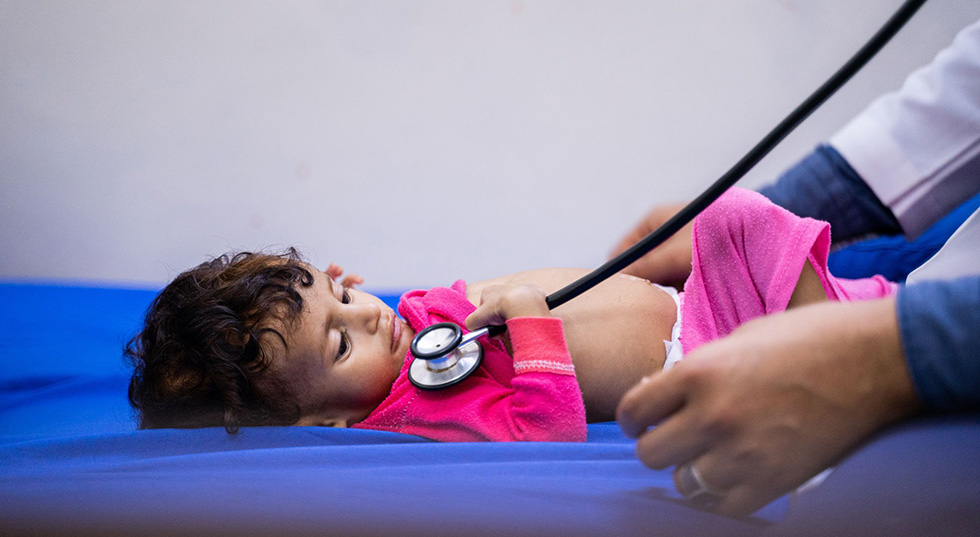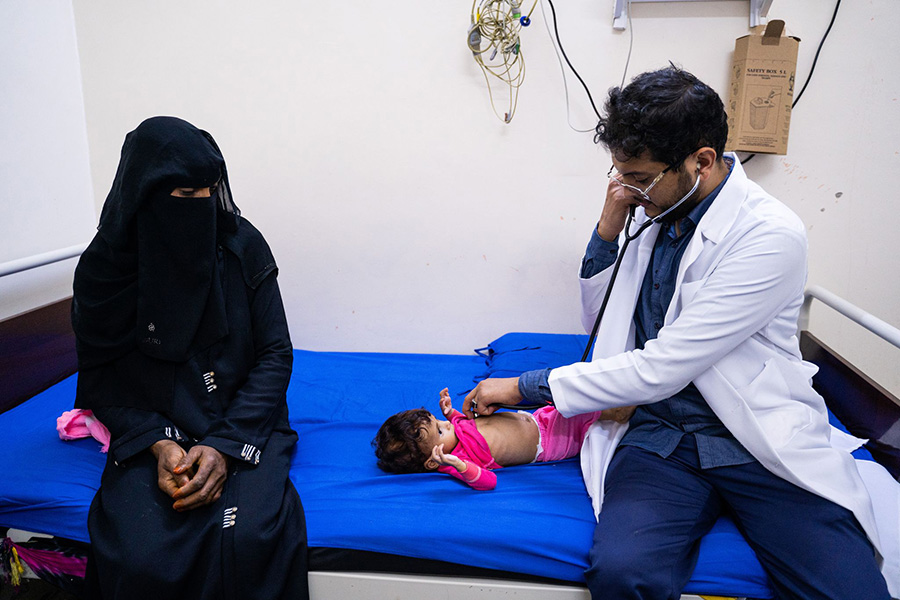
11 February 2024 – In war-ravaged Yemen, children’s lives are overshadowed by poverty, malnutrition, and diseases, robbing them of a carefree childhood. An estimated 5 million children in the country are acutely malnourished.
Behind this number are the individual stories of children facing malnutrition, families struggling to afford treatment, and journeys made to seek help. Families in Yemen not only struggle to keep their children safe from war but also from death from hunger and disease as a result of poverty made worse by the ongoing crisis. At the same time, the health system is crumbling under the weight of the conflict.
Yemen’s conflict-driven economic and humanitarian crisis has shattered the country’s health system, disrupting basic health services at health facilities across the country. With the system unable to address the increasing emergence of diseases, families are left struggling to access basic medical care.
 Dr Jamal Al Babeli, a dedicated doctor at the therapeutic feeding centre (TFC) at Bajil Hospital, Hudaydah governorate, embodies the hope that persists amid this despair. Fuelled by an ambition to become a doctor and his passion to elevate the country’s health standards, Dr Al Babeli realized his dream and completed his medical studies, even amid the difficulties in Yemen. Despite continuing to face immense challenges, he fights tirelessly to save the lives of children ravaged by malnutrition and disease.
Dr Jamal Al Babeli, a dedicated doctor at the therapeutic feeding centre (TFC) at Bajil Hospital, Hudaydah governorate, embodies the hope that persists amid this despair. Fuelled by an ambition to become a doctor and his passion to elevate the country’s health standards, Dr Al Babeli realized his dream and completed his medical studies, even amid the difficulties in Yemen. Despite continuing to face immense challenges, he fights tirelessly to save the lives of children ravaged by malnutrition and disease.
Dr Al Babeli works within a network of 4 TFCs supported by WHO through its support from the Central Emergency Response Fund (CERF). These centres provide life-saving nutrition interventions, essential medical supplies, oxygen and safe water to children suffering from malnutrition, dehydration and other illnesses.
In the second half of 2023, up to 1876 children were admitted, many from remote areas with limited access to health care. Cases often exceed capacity, forcing referrals to other strained facilities. Some children are admitted with dehydration or at a stage that is close to critical because of their family’s inability to have them brought to the hospital on time. Critical life-saving emergency care is then needed to save the children’s lives.
During the same period, 1876 children aged under 5 years were treated and their caregivers benefited from counselling. In addition, to ensure detection and referral to prevention or treatment, about 8703 children aged under 5 years were screened for different forms of malnutrition. Acute malnutrition was identified in 40% of these children, who were then referred to therapeutic feeding programmes for treatment.
“We couldn’t stand by helpless – quality care was provided at no cost,” said Dr Al Babeli, sharing the moving case of a child in critical condition, whose family was unable to afford treatment. “Most admitted children – 99% – cannot afford treatment. Thanks to collaboration like WHO and CERF, it’s free, significantly reducing the death rate.”
Free-of-charge treatment has significantly reduced mortality rates, highlighting the impact of the WHO–CERF project. Cost of treatment is not the only hurdle, though: reaching the TFC can also be costly for families, who must divert already scarce resources from basic needs to do so. WHO-supported transportation assistance eases this burden. WHO buys and distributes admission kits and covers transportation costs for caregivers, easing their financial burden.
To ensure children’s long-term health, counselling sessions equip families with essential knowledge on proper nutrition and feeding practices, and how to follow up with the outpatient therapeutic feeding programme to get medication if needed. WHO also supports early childhood development activities in baby-friendly spaces to enhance the recovery progress of young children.
Through this collaboration, nearly 112 paid medical workers who provide life-saving care have received crucial training to strengthen quality service delivery. The free services have demonstrably reduced the death rate for malnourished children by offering a lifeline to families who cannot afford treatment for their children.
Dr Al Babeli himself has benefited from on-the-job training, gaining specialized skills in the treatment of malnourished children. “I became more confident in my work,” he explained. “Working at the TFC has given me a new set of skills and knowledge. I have learned clinical diagnosis and methods of treating malnourished children, who differ from other children in terms of criticality of the cases.”
“My experience in dealing with malnourished children made me more passionate about elevating the level of health. Having the ability to save a child affected by malnutrition and disease ... is worth the life itself,” declared Dr Al Babeli. His dedication, fuelled by passion, offers hope in Yemen’s fight for a healthier future for its children.
With CERF support, WHO has addressed the needs of children suffering from the complications of severe acute malnutrition. It has also provided health care for patients referred from the community and other health structures by supporting referral hospitals in 3 districts. WHO also provided essential medicines, medical supplies and rapid diagnostic tests and supported disease surveillance through rapid response teams in the targeted districts to detect and urgently respond to outbreaks. More than 22 000 patients benefited from the health and referral services provided by WHO and its national nongovernmental organization partners.




